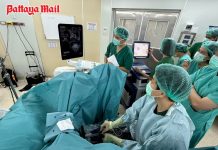The term diverticular disease comes from the Latin word diverticulum which means a “small diversion from the normal path”. However, Max Hickey, my anatomy professor claimed that the word diverticulum was Latin for a wayside inn of ill repute. I remember Max Hickey’s definition with fondness.
 The colon or large intestine is that part of the intestinal tract which stores fecal residue for elimination from the body. The small blood vessels which supply blood to the large intestine or colon do so by penetrating the muscle coat of the colon thereby producing a small defect through which the inner lining can protrude or herniate out. These small protrusions are called diverticulae (plural of diverticulum).
The colon or large intestine is that part of the intestinal tract which stores fecal residue for elimination from the body. The small blood vessels which supply blood to the large intestine or colon do so by penetrating the muscle coat of the colon thereby producing a small defect through which the inner lining can protrude or herniate out. These small protrusions are called diverticulae (plural of diverticulum).
Diverticulae are more common in industrialized countries than in third world countries. The reason given for this is the lack of bulk present in the diet of industrialized countries allowing muscle contractions to create localized areas of high pressure allowing diverticulae to form. The pressure created by muscle contractions of the left side (sigmoid) of the colon are considerably greater than those of the right side (ascending colon). This fact explains why diverticulae are more common on the left than right side of the colon. The prevalence of diverticulae clearly increases with age. While fairly uncommon during the first 4 decades of life they reach a frequency of 50% in people greater than 65 years old. Oh the joys of advancing years!
It is very important to realize the most common symptom produced by diverticulae is none! In other words, diverticular disease of the colon most often causes no difficulty and no symptoms and is only found post mortem. In other words, you die with it, not from it.
When they do cause symptoms, they can do so in one of two ways: First they can rupture into the abdominal cavity, cause localized irritation and inflammation or produce an abscess. This is called acute diverticulitis. The suffix “itis” means inflammation. So an inflamed diverticulum is called diverticulitis. Patients who have diverticulitis often will present with the rather sudden onset of pain located in the lower left part of the abdomen over the sigmoid colon. It frequently is exquisitely tender and is associated with fever and a high white blood cell count. Secondly, they can painlessly start to have significant amounts of rectal bleeding.
Acute diverticulitis can frequently be diagnosed by a typical history and a physical exam showing impressive tenderness over the sigmoid colon which is located in the left lower part of the abdomen. If fever and a high white blood cell count are present this is confirmatory.
Acute diverticulitis is treated with antibiotics for 7-10 days. These antibiotics frequently may have to be given intravenously. Diet is often severely limited during the first few days of treatment. Most patients will recover completely, but occasionally surgery is necessary in order to drain all the infected material and completely empty an abscess cavity. At times this can require the creation of a colostomy to totally divert the fecal stream away from the infected area. After this has healed (usually about 6 weeks) the colostomy is removed and the colon is restored to its original state with removal of the diseased portion of the colon.
Bleeding diverticulosis is managed initially by monitoring the patient closely regarding his rate of blood loss and giving blood transfusions if necessary. Fortunately the bleeding normally stops. If not, the part of the colon containing the bleeding diverticulum needs to be surgically removed. This is often performed as an emergency operation.
Diverticulitis should not be confused with Irritable Bowel Syndrome which is another condition with symptoms referable to the colon (bowel).
The medical fraternity likes to catalog stages of disease and diverticulitis is classified by the Hinchey stages (After Dr Hinchey).
The Hinchey classification – proposed by Hinchey et al. in 1978 classifies a colonic perforation due to diverticular disease. The classification is I-IV:
Hinchey I – localized abscess (para-colonic)
Hinchey II – pelvic abscess
Hinchey III – purulent peritonitis (the presence of pus in the abdominal cavity)
Hinchey IV – feculent peritonitis. (Intestinal perforation allowing feces into abdominal cavity).
So now you know.





